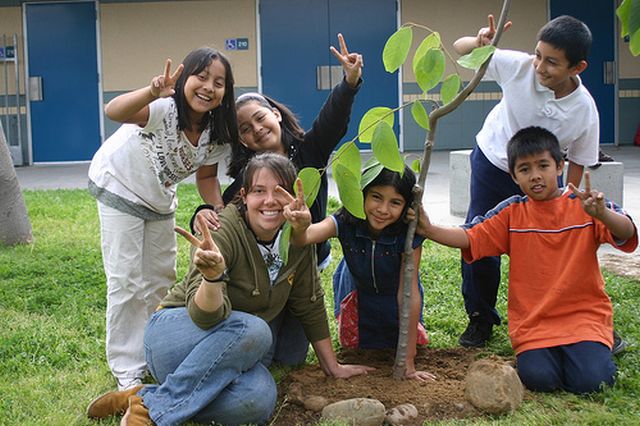
Obesity and diet-related diseases are major public health problems in United States’ “food deserts” — communities where access to affordable, quality, and nutritious foods is difficult; they have easier access to fast food restaurants but limited access to supermarkets. According to the Centers for Disease Control and Prevention, about 17% (or 12.7 million) of American children and adolescents aged 2—19 years are obese.
United States Department of Agriculture’s Economic Research Service says that over 23.5 million Americans, including more than 6.5 million children, live in low-income areas more than one mile from a supermarket partial access to which denies these communities the recommended level of fruits, vegetables, whole grains and low-fat dairy products.
To make neighborhoods healthier as well as improve children’s eating habits, Common Vision — a nutritional justice nonprofit organization – aims to plant 1,000 orchards at low-income public schools.
Till last year, Common Vision played an important role in student health by delivering access to free, fresh, organic fruit to nearly 100,000 kids at 215 public schools. However, in August 2015, Common Vision launched the “Grow Fruit Grow Power” crowd-funding campaign to raise funds to plant fruit trees in 1,000 California schools to create extremely high-yielding, low-maintenance, and low-cost school orchards by 2025.
The campaign successfully reached its crowd-funding goal of $60,000 but still welcomes additional support. Grammy Award-winning singer and songwriter Jason Mraz, a longtime proponent of eating healthy food and supporter of Common Vision’s campaign, says:
“Planting an orchard is such an amazing experience. They grow for decades providing more than just nutrition, but the educational tools for science, technology, engineering, and math – you name it.”
Common Vision not only wants to plant fruit trees, it wants to educate students on the important processes of maintaining and sustaining the orchards. The organizers write:
“In addition to growing the number of schools we reach, we’re setting our sights on deeper interactions with each site and its students. Your funds will go towards developing school curriculum, launching dozens of easily adopted orchard activities, expanding the orchards to include understory gardening and perennial vegetables, and even to build outdoor kitchens among the trees. With your help, these efforts will nourish, educate, and inspire millions more children.”
By February 2016, Common Vision helped start orchards at more than 230 schools from the Mexico border to the Bay Area and Sacramento. In addition to planting the trees, writes Lompoc Record, Common Vision workers visit each school regularly to check on the trees and prune them as well as maintain the irrigation systems, which they also install on a timed drip system. Michael Flynn, executive co-director of Common Vision, told Lompoc Record:
“In addition to teaching students about how trees grow and the botany process, we also discuss issues such as climate change and carbon sequestration, and kids get an opportunity to understand hands-on how trees interact with soil to take atmospheric carbon and store it in the ground. This really helps kids understand photosynthesis and underground interaction with roots, microorganisms and soil that serve as the backbone for creating organic-rich matter.
“Their work could have a lasting impact. What they come to own is that they could share their energies with their classmates and their school and the students who will come to their school over the next century.”
In 2010, Congress passed the Healthy, Hungry-Free Kids Act, which implemented nutritional standards for foods sold and provided in public school cafeterias, limiting portion size, increasing servings of whole grains, and cutting back on sugar, fat, and sodium. However, according to a recent University of Vermont study, while students picked more fruits and vegetables during lunch under the new government mandate, they actually put those fruits and vegetables into the trash instead of their mouths.
This shows that making it compulsory to provide healthier food doesn’t guarantee its consumption by children. An educational outreach — similar to Common Vision’s — is also required to engage and inspire the fast food crazy young generation.
What are your thoughts? Please share your views in the comments section below…
This article (Activists On A Mission To Plant 1,000 Orchards In Low-Income Schools) is free and open source. You have permission to republish this article under a Creative Commons license with attribution to the author and AnonHQ.com.





